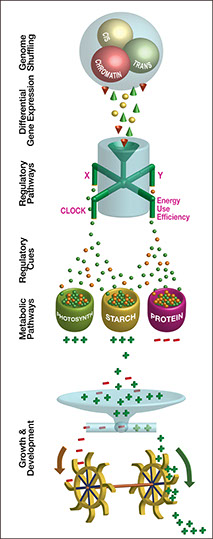Heterosis:
Emerging ideas about hybrid vigour (2012)
Perceived by Charles Darwin in many vegetable plants and rediscovered by George H. Shull and Edward M. East in maize, heterosis or hybrid vigour is one of the most widely utilized phenomena, not only in agriculture but also in animal breeding. Although, numerous studies have been carried out to understand its genetic and/or molecular basis in the past hundred years, our knowledge of the underlying molecular processes that results in hybrid vigour can best be defined as superficial. Even after century long deliberations, there is no consensus on the relative/individual contribution of the genetic/epigenetic factors in the manifestation of heterosis. However, with the recent advancements in functional genomics, transcriptomics, proteomics and metabolomics related technologies, the riddle of heterosis is being reinvestigated by adopting systems level approaches to understand the underlying molecular mechanisms. A number of intriguing hypotheses are converging towards the idea of cumulative positive effect of differential expression of a variety of genes, on one or several yield-affecting metabolic pathways or overall energy-use efficiency, as the underlying mechanism for the manifestation of heterosis. We have proposed a model for manifestation of hetrosis which could provide better scientific understanding of this process.


A model outlining the mechanistic aspects of manifestation of heterosis
Mixing of two adequately distant genomes brings about cis, trans, and chromatin level changes in the hybrid, which results in differential expression of a number of genes. These expression patterns, which might represent additive or non-additive modes of gene action, may primarily affect a few major regulatory pathways which, in turn, send out regulatory cues that either individually or cumulatively affect a number of downstream metabolic pathways (including photosynthesis, starch and protein metabolism, etc.) in either a positive or a negative manner. These individual pathways, whether placed on the input side or the consumption side of the energy equation, affect various aspects of growth and development. The net positivity or negativity in the system, therefore, would define the state and extent of heterosis.

Department of Plant Molecular Biology, University of Delhi South Campus, New Delhi-110021, India
